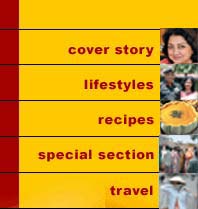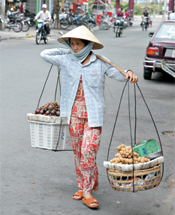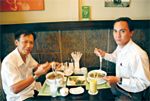


 International Beat
International Beat Vietnam On The Travelers List |
|
In the early 17th century, when the first settlers, Vietnamese from the North and Central provinces landed in South, the land here was covered by dense forests and marshes. These were ethnic tribes such as the Khmer, the Steng, and the Ma, the majority of them poor peasants ruined by feudal clans, and the rest of them either soldiers of the feudal government or runaway convicts. These were people who had sailed up the Saigon River to land in the area of today's Saigon, or Ho Chi Minh City , if you prefer. After I had drunk in the beauty of the place, imbibed its stillness, let calmness seep into me, I gathered my mind and set about the task at hand, talking to the ghoda-walas who bring the pilgrims up, the people serving the langar, and of course shooting pictures. Returning past the Lakshman temple I sat awhile and talked to the priest. It was here that Lakshman performed penance. It is said he meditated by the lake and regained his health after being severely wounded by Megnath, son of the Demon Ravan, during the battle. It was after a lot of patriotic struggle and decades later that the Vietnamese Communist Party was established on February 3, 1930 by its President, Ho Chi Minh. A blueprint for
national liberation and a strategy to fight against invasion and feudalism took shape. But it was only in the period between 1939-1945 that the revolution rose to a peak. When the World War II ended in the unconditional surrender of the Fascists to the Allies, the Party launched a country wide resistance war. But it was only in August that a milestone in the history of the country took place, when within 12 days (August 14 to 25), the people under the leadership of President Ho Chi Minh seized the political power. The August Revolution completely destroyed the Colonialists and feudal regime and helped set up the Democratic Republic of Vietnam, turning Vietnamese people from slaves to owners of the country. But all was not yet hunky dory. Vietnam still had to encounter illiteracy, hunger and more invasions. This time by the Chinese and Japanese soldiers and the British forces.
Alongside the French were also trying to reoccupy Vietnam . But the spirit of the Vietnamese was kindled and they were ready to fight for their freedom. Which they did, with rudimentary weapons, opting to risk their lives, rather than be occupied, thus starting a 30 year resistance war to protect their independence and re-unification.
In this time, nothing could keep the Vietnamese from fighting for national independence, liberty and re-unification. The entire country fought like never before. Finally the war ended in victory on April 30, 1975, Saigon and the Southern region was finally liberated.In 1976, after the re-unification, the National Assembly unanimously decided to rename Saigon-Cholon-Gia as Ho Chi Minh City after its benevolent president who had died in 1969.
Since then to now, HCM City or Saigon has changed. Industrialisation, modernisation, beautification, it has seen it all. It is a city which is today the driving force of the country, contributing vastly to its economy. It has become a sizeable tourism center, attracting millions to its breath taking beauty, its strangeness, its mystery. At once traditional and modern, with its lovely homes, superb architecture, world class offices, exquisite art galleries, fantastic shopping, chic cafes and delectable cuisine! But above all a salute to the spirit of a country which has been ravaged for centuries and has come out of it admirably.
|

Home Page
About the mag
Subscribe
Advertise
Contact Us
 At first they settled along the riverside and later moved outward to reclaim cultivable land from forests, marshes and the plains. They started to then build homes and hamlets, gardens and rice fields. By the middle of the 17th century some 10,000 people had inhabited the Saigon area.
At first they settled along the riverside and later moved outward to reclaim cultivable land from forests, marshes and the plains. They started to then build homes and hamlets, gardens and rice fields. By the middle of the 17th century some 10,000 people had inhabited the Saigon area.
 From then to now much water has flown down the Saigon River . French colonialist occupied Saigon from where they invaded the rest of the country, dividing it into three regions with three policies, concentrating into converting the south into a colony, with a lot of attention on Saigon which they christened � Pearl of the Far East � and �Paris of Asia�.
From then to now much water has flown down the Saigon River . French colonialist occupied Saigon from where they invaded the rest of the country, dividing it into three regions with three policies, concentrating into converting the south into a colony, with a lot of attention on Saigon which they christened � Pearl of the Far East � and �Paris of Asia�.  Their struggles paid. With the Geneva Treaty (1954) half of Vietnam from latitude 17 northward was liberated. The South was still occupied. And then the US imperialists entered the fray replacing the French colonialists! The resistance war against the Americans lasted for 21 years.
Their struggles paid. With the Geneva Treaty (1954) half of Vietnam from latitude 17 northward was liberated. The South was still occupied. And then the US imperialists entered the fray replacing the French colonialists! The resistance war against the Americans lasted for 21 years.